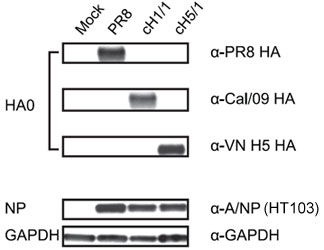Anti-Influenza A, Nucleoprotein [HT103] Antibody
The HT103 monoclonal antibody was generated against an Influenza A whole virus and is specific for the nucleoprotein (NP) of all Influenza A viruses. The antibody has been tested via WB, ELISA, and IHC experiments.
The nucleoprotein (NP) of Influenza virus encapsulates the negative strand of the viral RNA and is essential for replicative transcription. It may also be involved in other essential functions throughout the virus life cycle. As well as binding ssRNA, NP is able to self associate to form large oligomeric complexes. NP is able to interact with a variety of other macromolecules of both viral and cellular origins. It binds the PB1 and PB2 subunits of the polymerase and the matrix protein 1 (M1).
From the laboratory of Thomas M. Moran, PhD, Icahn School of Medicine at Mount Sinai.
The HT103 monoclonal antibody was generated against an Influenza A whole virus and is specific for the nucleoprotein (NP) of all Influenza A viruses. The antibody has been tested via WB, ELISA, and IHC experiments.
The nucleoprotein (NP) of Influenza virus encapsulates the negative strand of the viral RNA and is essential for replicative transcription. It may also be involved in other essential functions throughout the virus life cycle. As well as binding ssRNA, NP is able to self associate to form large oligomeric complexes. NP is able to interact with a variety of other macromolecules of both viral and cellular origins. It binds the PB1 and PB2 subunits of the polymerase and the matrix protein 1 (M1).
From the laboratory of Thomas M. Moran, PhD, Icahn School of Medicine at Mount Sinai.
| Product Type: | Antibody |
| Antigen: | Influenza A Nucleoprotein (NP) |
| Accession ID: | P03466 |
| Molecular Weight: | 56.2kDa |
| Isotype: | IgG2a |
| Clonality: | Monoclonal |
| Clone Name: | HT103 |
| Reactivity: | Binds NP of all viruses tested. Stains infected cells. |
| Immunogen: | Whole virus |
| Species Immunized: | Mouse |
| Purification Method: | Protein G |
| Buffer: | 0.1M Sodium Phosphate, pH 7.4, 0.15M NaCl, 0.05% (w/v) Sodium Azide |
| Tested Applications: | WB (1:200-1:1000), ELISA (1:200-1:1000), IHC (1:200-1:1000) |
| Storage: | -20C |
| Shipped: | Cold packs |
Detection of NP in infected cells by Western blotting with the antibody HT103

Western blot analysis of MDCK cells infected with the recombinant cHA-expressing viruses. NOTE: anti-A/NP is HT103.
Adapted from: Hai, R., et al., J Virol 86:5774-5781.
- Hai, R., F. Krammer, G.S. Tan, N. Pica, D. Eggink, J. Maamary, I. Margine, R.A. Albrecht, and P. Palese. Influenza viruses expressing chimeric hemagglutinins: globular head and stalk domains derived from different subtypes. J Virol 86:5774-5781.
- Gao, Q., Y.Y. Chou, S. Doganay, R. Vafabakhsh, T. Ha, and P. Palese. The influenza A virus PB2, PA, NP, and M segments play a pivotal role during genome packaging. J Virol 86:7043-7051.
- Tan, G.S., F. Krammer, D. Eggink, A. Kongchanagul, T.M. Moran, and P. Palese. A pan-H1 anti-hemagglutinin monoclonal antibody with potent broad-spectrum efficacy in vivo. J Virol 86:6179-6188.
- O'Neill, R.E., J. Talon, and P. Palese. 1998. The influenza virus NEP (NS2 protein) mediates the nuclear export of viral ribonucleoproteins. EMBO J 17:288-296.
- Garcia-Sastre, A., R.K. Durbin, H. Zheng, P. Palese, R. Gertner, D.E. Levy, and J.E. Durbin. 1998. The role of interferon in influenza virus tissue tropism. J Virol 72:8550-8558.
- Gao, Q., A.C. Lowen, T.T. Wang, and P. Palese. A nine-segment influenza a virus carrying subtype H1 and H3 hemagglutinins. J Virol 84:8062-8071.
- Richards, K.A., F.A. Chaves, S. Alam, and A.J. Sant. Trivalent inactivated influenza vaccines induce broad immunological reactivity to both internal virion components and influenza surface proteins. Vaccine 31:219-225.
- Lukarska M, Fournier G, Pflug A, Resa-Infante P, Reich S, Naffakh N, Cusack S. Structural basis of an essential interaction between influenza polymerase and Pol II CTD. Nature. 2017 Jan 5;541(7635):117-121. doi: 10.1038/nature20594. PubMed PMID: 28002402. View Article
- de Castro Martin IF, Fournier G, Sachse M, Pizarro-Cerda J, Risco C, Naffakh N. Influenza virus genome reaches the plasma membrane via a modified endoplasmic reticulum and Rab11-dependent vesicles. Nat Commun. 2017 Nov 9;8(1):1396. View Article
- Uccellini MB, García-Sastre A. ISRE-Reporter Mouse Reveals High Basal and Induced Type I IFN Responses in Inflammatory Monocytes. Cell Rep. 2018 Dec 4;25(10):2784-2796.e3. View Article
- Yang S, Harding AT, Sweeney C, Miao D, Swan G, Zhou C, Jiang Z, Fitzgerald KA, Hammer G, Bergo MO, Kroh HK, Lacy DB, Sun C, Glogauer M, Que LG, Heaton NS, Wang D. Control of antiviral innate immune response by protein geranylgeranylation. Sci Adv. 2019 May 29;5(5):eaav7999. View Article
- Calderon BM, Danzy S, Delima GK, et al. Dysregulation of M segment gene expression contributes to influenza A virus host restriction. PLoS Pathog. 2019;15(8):e1007892. Published 2019 Aug 15. View article
- Omi J, Watanabe-Takahashi M, Igai K, et al. The inducible amphisome isolates viral hemagglutinin and defends against influenza A virus infection. Nat Commun. 2020;11(1):162. Published 2020 Jan 9. View article
- Declercq M, Biquand E, Karim M, Pietrosemoli N, Jacob Y, Demeret C, Barbezange C, van der Werf S. Influenza A virus co-opts ERI1 exonuclease bound to histone mRNA to promote viral transcription. Nucleic Acids Res. 2020 Sep 22:gkaa771. View article
- Tsai K, Courtney DG, Kennedy EM, Cullen BR. Influenza A virus-derived siRNAs increase in the absence of NS1 yet fail to inhibit virus replication. RNA. 2018;24(9):1172-1182. View article
If you publish research with this product, please let us know so we can cite your paper.

![Anti-Influenza A, Nucleoprotein [HT103] Antibody Anti-Influenza A, Nucleoprotein [HT103] Antibody](https://www.kerafast.com/MediaStorage/Product/Images/Medium/757_200120200126207560.jpg)
